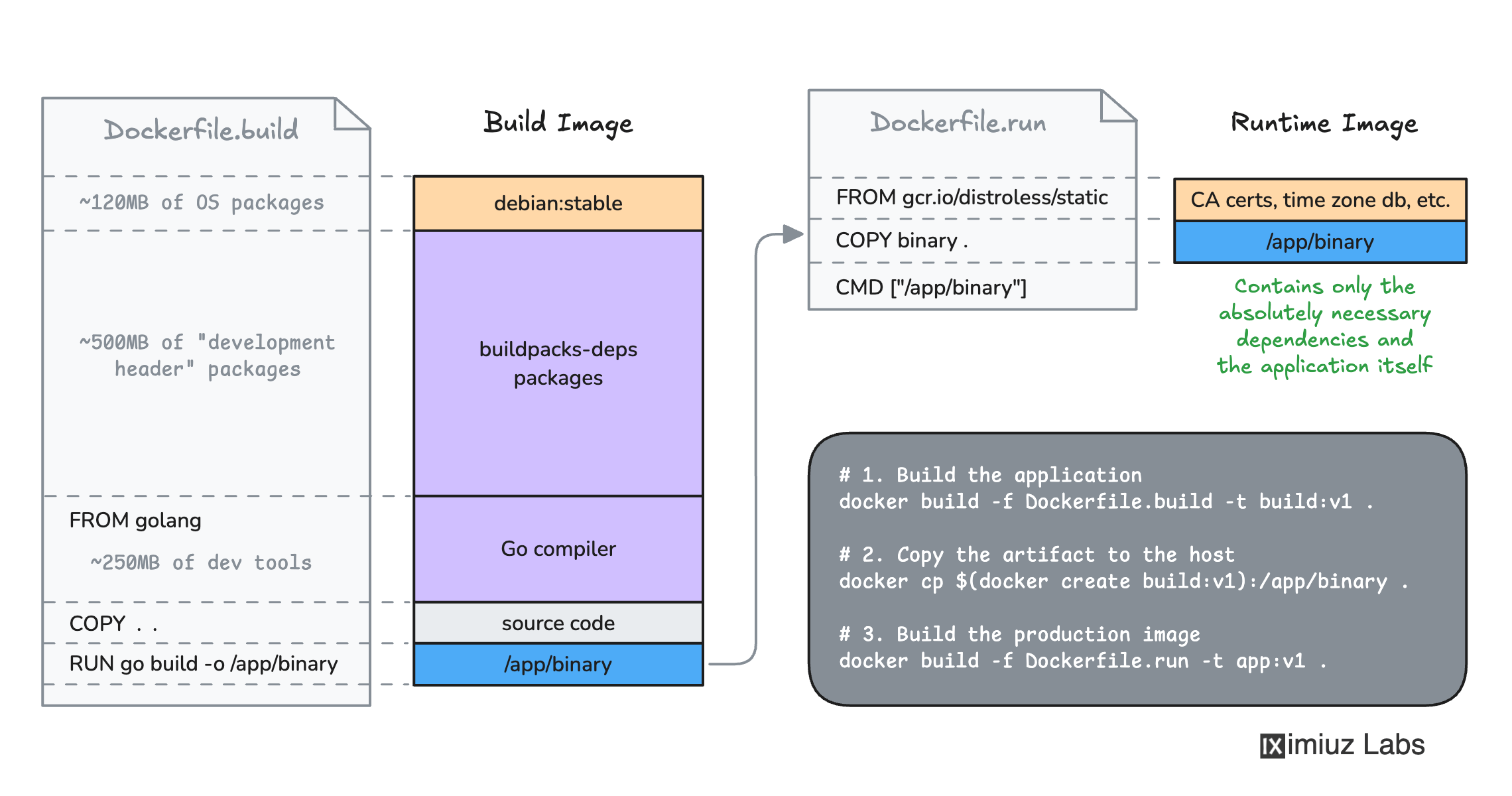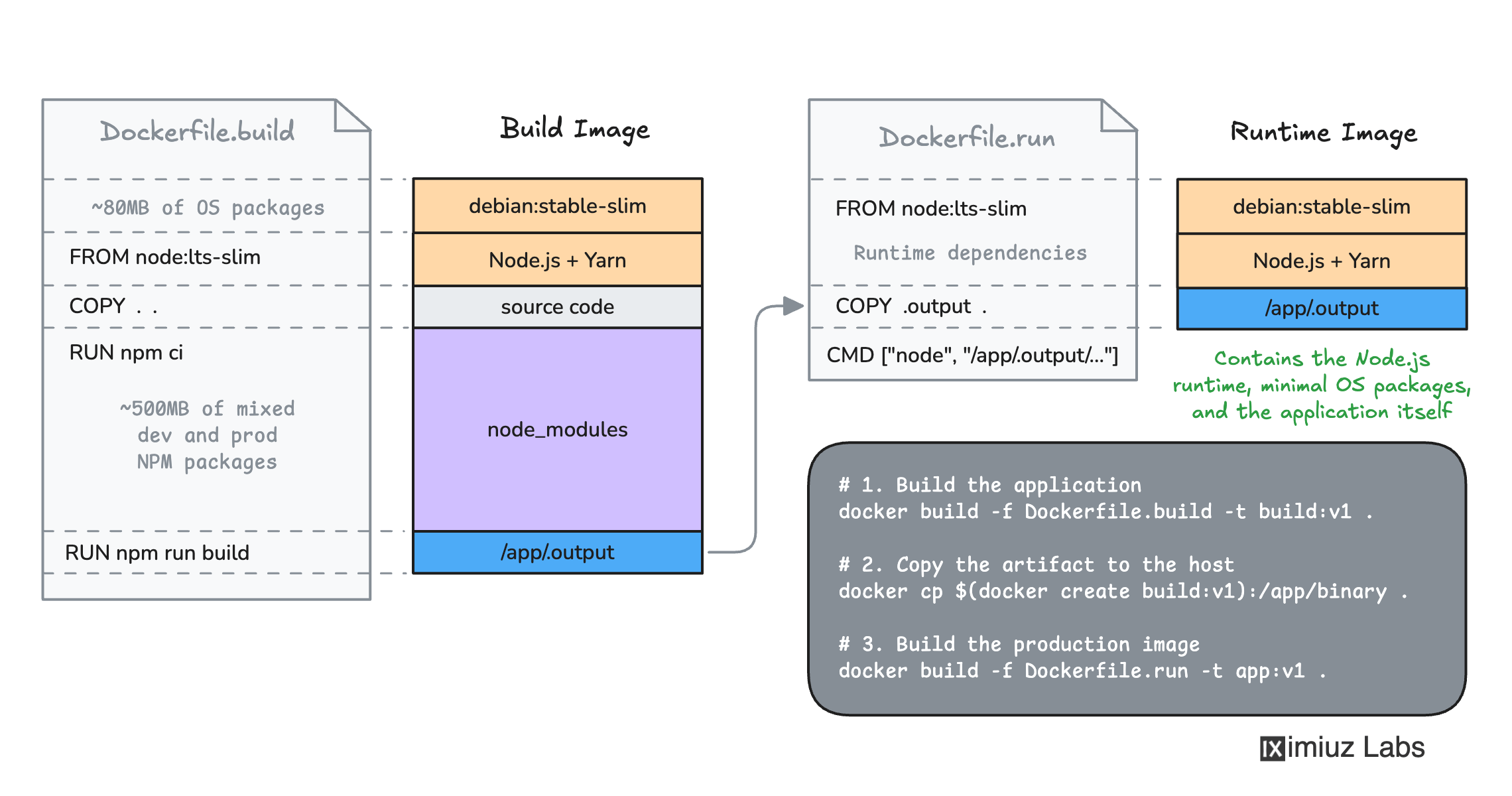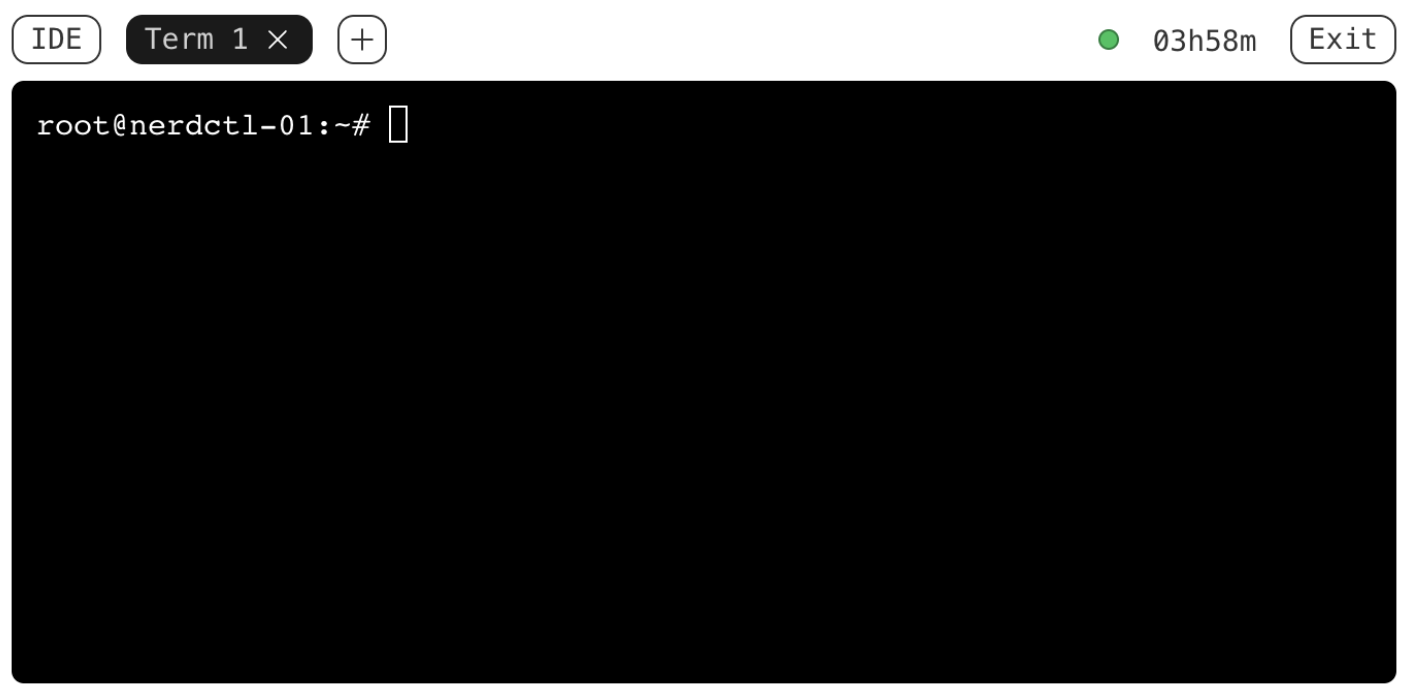Sample Tutorial
This is a self-documenting sample that serves as a guide on how to author tutorials on iximiuz Labs. You can find the source of this document on GitHub. Feel free to use it as a starting point for your own tutorials.
What is a Tutorial on iximiuz Labs?
Tutorials are deep dives into DevOps and server-side topics where theory blends with hands-on examples. You can think of them as a combination of a traditional blog post and a Linux playground. A tutorial can be just a few paragraphs long or as large as a book (but in the latter case, please consider splitting it into multiple tutorials or turning it into a course).
What makes iximiuz Labs tutorials special:
- Explanatory drawings, screenshots, and diagrams.
- Reproducible shell commands and code snippets.
- Interactive tasks with immediate feedback.
- Ability to access the playground directly from the browser.
- Complementary challenges for more comprehensive learning experience.
Assuming the tutorial is published and accessible (see access control below), non-authenticated users are typically allowed to read the tutorial's content, while authenticated users can start the tutorial's playground and mark the tutorial as completed, with the corresponding progress reflected in their personal dashboard.
How to Edit the Tutorial
At the moment, iximiuz Labs does not offer a WYSIWYG editor.
Instead, content editing is expected to be done on your local machine,
while the changes are real-time streamed to the page by labctl,
providing immediate feedback via the traditional hot-reloading experience.
This approach allows you to write content in your favorite markdown editor or even a full-fledged IDE, keeping the full control over the raw content source and staying out of the way of any AI-powered features of your editor.
We encourage you to store the source of your tutorials in a git repository, similarly to how you manage code projects. This way, you can benefit from the versioning and backup features of git.
To get the up-to-date instructions on how to install and use labctl,
click "Open in Editor" button in the tutorial's menu:
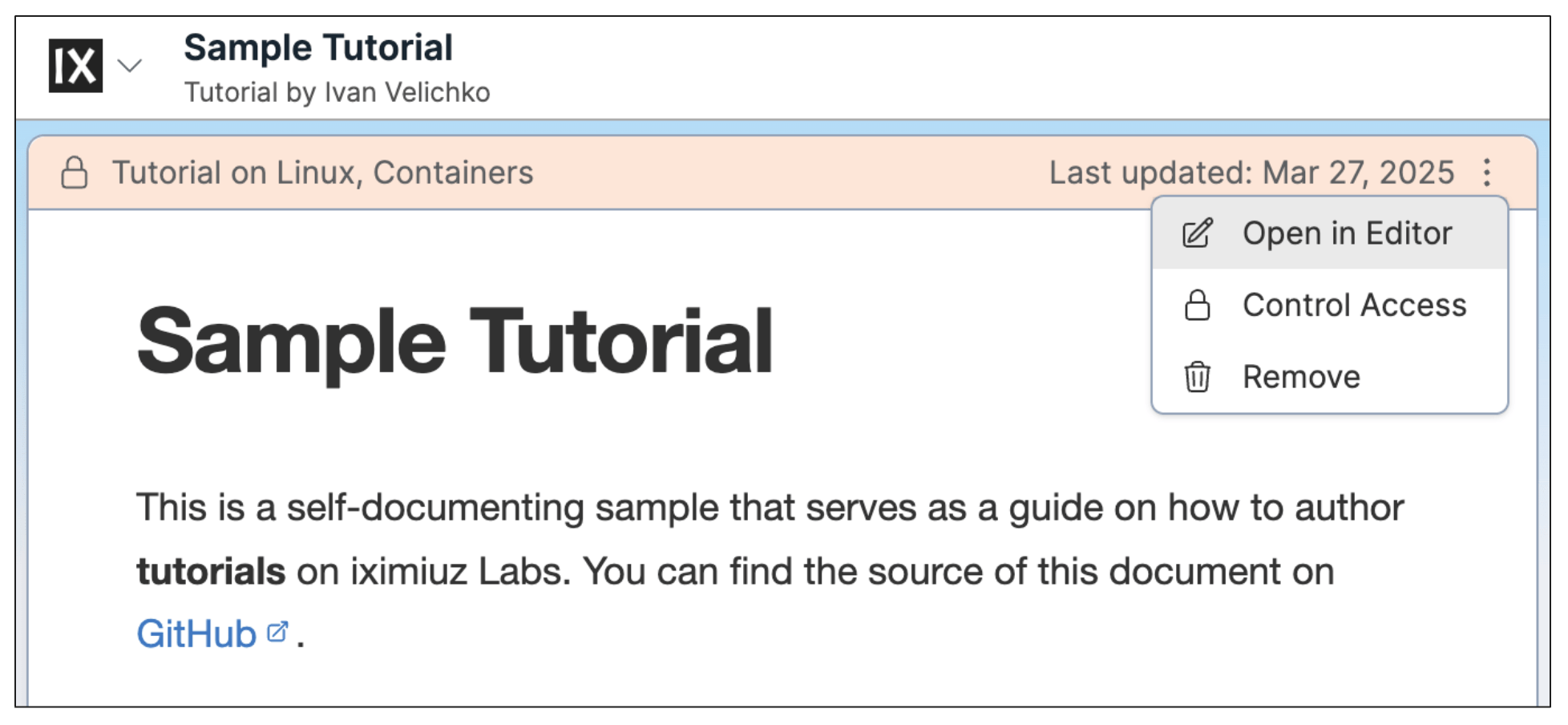
How to Control Tutorial Access
Authors can control who can list, preview, read, and start their tutorials. Every tutorial starts as a private draft, meaning only the author can access it. When the tutorial is ready, the author can choose to make it public (accessible to everyone with the link) or configure more granular access.
The access control settings can be opened from the tutorial's menu:
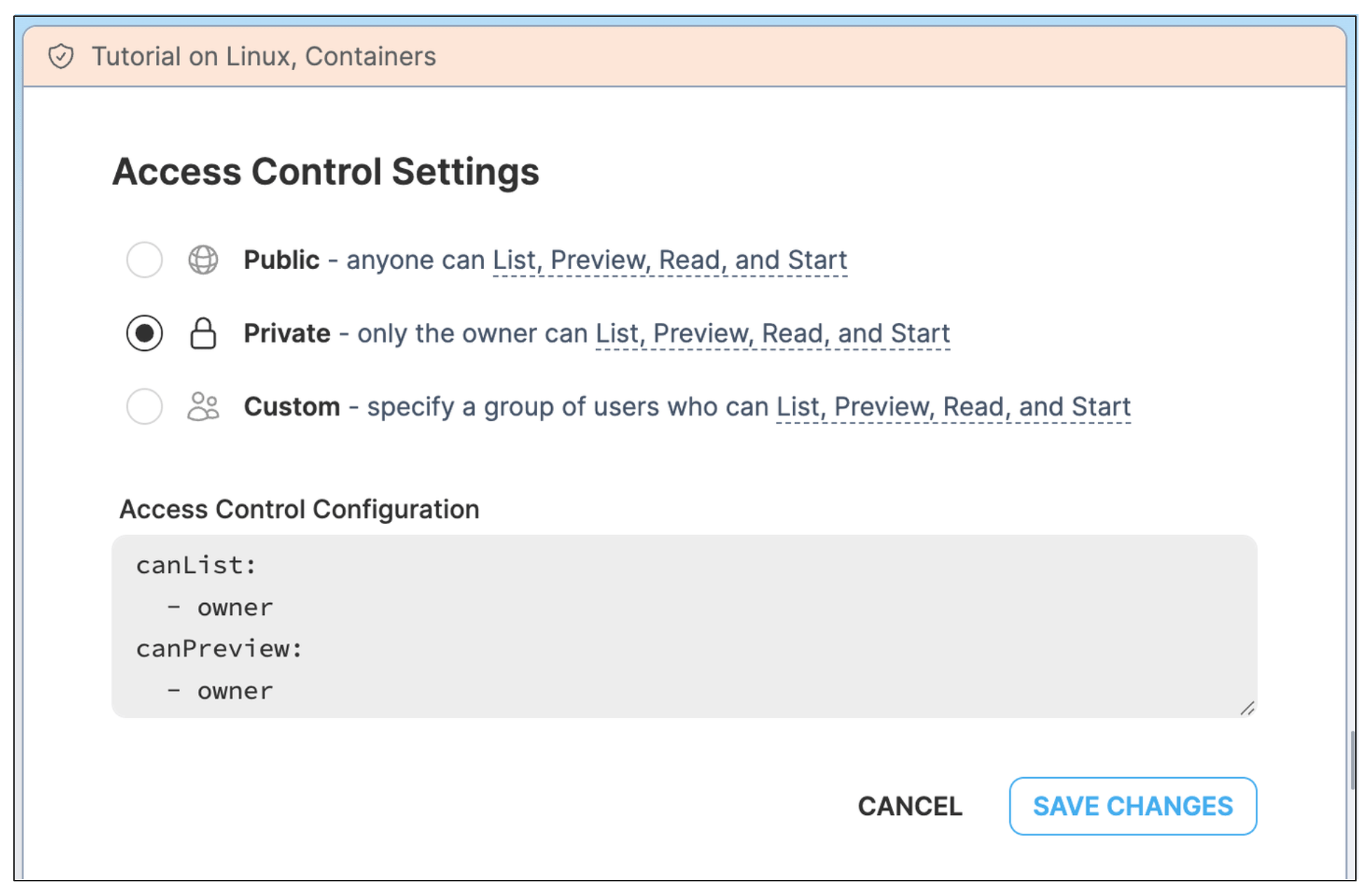
While publication via a direct link is always possible,
the iximiuz Labs team reserves the right to choose which tutorials will be listed in the catalog(s).
Setting canList to ["anyone"] is treated only as an indicator of the author's willingness to list the tutorial in one of the platform's catalogs.
Authors can explicitly prohibit listing by setting the canList attribute to ["owner"].
Tutorial Metadata and Front Matter
Every tutorial is represented by a markdown file that begins with a YAML front matter block. The smallest possible front matter block for a tutorial should contain the following fields:
---
kind: tutorial
title: My Awesome Linux Containers Tutorial
description: |
A deep dive into managing containers with practical, hands-on examples.
categories:
- linux
- containers
tagz:
- example
- tutorial-docs
createdAt: 2025-03-26
cover: <image filename from the __static__ folder>
---
The above fields are essential because they feed the platform with information used for indexing, navigation, and displaying your tutorial. However, iximiuz Labs also supports a number of additional fields that can be used to:
- Specify the tutorial's playground and its customization options.
- Define init, helper, and verification tasks to be executed on the playground's VMs.
- List accompanying the tutorial challenges to later embed them with the challenge card component.
Click here to see the full list of supported Front Matter fields
---
kind: tutorial # fixed
title: <string> # required, 10-120 characters
description: <string> # required, up to 500 characters
# Up to 2 categories from the closed list:
# - linux
# - networking
# - containers
# - kubernetes
# - programming
# - observability
# - security
# - ci-cd
categories: # required
- category-1
- category-2
# Up to 5 tags, preferably from the already existing ones:
# curl https://labs.iximiuz.com/api/content/tags?kind=tutorial
tagz: # required
- tag-1
- tag-2
createdAt: <string> # required, format: YYYY-MM-DD[THH:MM:SS]
updatedAt: <string> # optional, format: YYYY-MM-DD[THH:MM:SS]
cover: <image filename from the __static__ folder> # required
playground: # optional
name: <string>
machines: ...
tabs: ...
tasks: # optional
task_name_1:
...
task_name_2:
...
challenges: # optional
challenge_key_1: {}
challenge_key_2: {}
---
Tutorial Markdown
The front matter section is followed by the markdown content of the tutorial. All standard markdown elements are supported, including:
- Bold, italic, and underlined text.
- Headings and subheadings.
- Paragraphs, lists, tables, etc.
- Code blocks with optional syntax highlighting.
- Image embedding with the
syntax. - Relative and absolute links with the
[text](url)syntax.
In addition, iximiuz Labs extends standard markdown with rich visual and interactive components (see MDC).
Content Folder Structure
For convenience, iximiuz Labs allows authors to store any files related to the tutorial in the same directory as the tutorial's markdown file. Here is a typical folder structure for a tutorial:
my-tutorial/
├── index.md
├── ...other files...
└── __static__
├── cover.png
└── image.png
All files in the my-tutorial directory are automatically uploaded to the remote content storage by labctl.
This is handy when you need to accompany the tutorial with some helper scripts, internal notes and drafts, etc.
Files other than the markdown content (i.e., index.md) and the static assets sub-folder are not accessible via the API,
so you are free to store any files in the tutorial's directory that are not intended to be seen by the users.
At the same time, the __static__ sub-folder is a special folder that is automatically uploaded to the CDN
and can be referenced in the tutorial's markdown using the __static__ prefix to:
- Embed images (see How to Embed Images below)
- Expose files (e.g., helper scripts) to be downloaded by the playground VMs
Unlike other files in the tutorial's directory, the __static__ folder is publicly accessible,
so you should not put any internal use-only information in it.
WARNING - UNPROTECTED ASSETS
⚠️ Do not put any sensitive information in __static__ folder ️⚠️
While the markdown content of tutorials (or any other forms of content on iximiuz Labs) is subject to full authorization checks, the static assets are not. This limitation is due to the extensive use of CND (e.g., Cloudflare) to deliver static assets with the best possible performance in all regions of the world.
With some careful URL-construction, files placed in the __static__
folder can be fetched via the API by potentially unauthorized users.
This includes anonymous users, bots, and crawlers. The caching duration
of these assets is also very long (up to 1 year).
If you wish to store private files alongside the content, make sure
to place them outside of the __static__ folder.
How to Embed Images
All images referenced in the tutorial's markdown must be stored in the __static__ directory next to the index.md file,
and their paths in the src attributes must be relative and start with __static__.
The labctl content push command will automatically upload all images from the static directory,
and the relative paths will be substituted with the actual URLs when the tutorial is rendered as a web page.
While the standard markdown syntax for embedding images is supported, iximiuz Labs also offers two rich MDC components for embedding images.
Zoom-able Images with the image-box Component
::image-box
---
:src: <image-name>.(png|jpg|...)
:alt: '<short image description>'
:max-width: 1000px # optional
:margin: 0px auto # optional
:padding: 10px # optional
:float: left|right # optional
---
_Optional caption goes here._
::
Example:
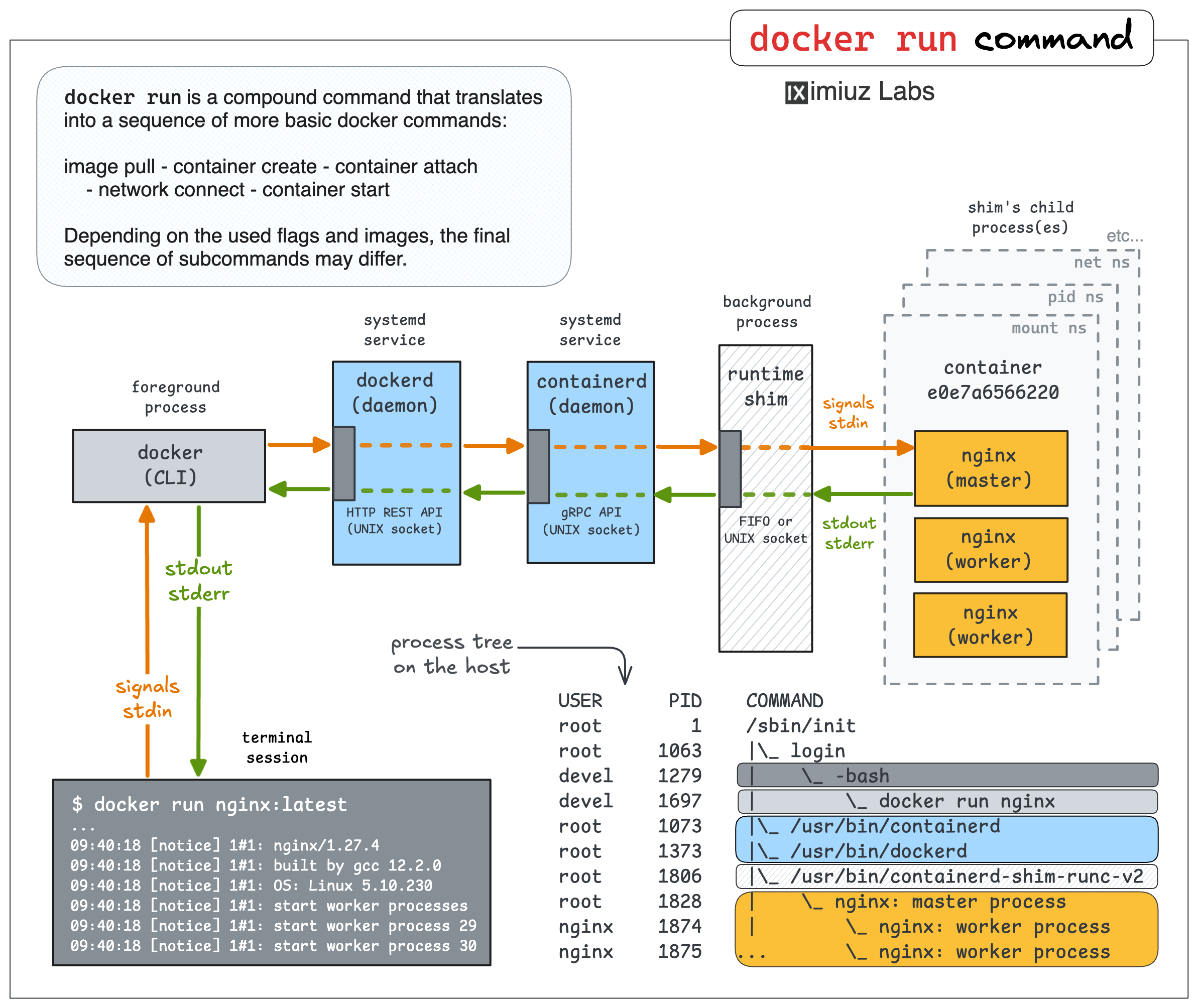
Click on the image to zoom in.
Slide Show with the slide-show Component
::slide-show
---
slides:
- image: <image1>.(png|jpg|...)
alt: <description of the first image>
- image: <image2>.(png|jpg|...)
alt: <description of the second image>
- ...
---
::
Example:
Help! My Images Aren't Updating
Images are cached by the CDN for up to 1 year and the cache key is the image's filename. This means that if you want to update an image you previously uploaded, you need to change the filename. You can follow a simple naming convention:
__stаtic__/image-v1.png
__stаtic__/image-v2.png
...
With the above naming convention, you'll also need to update the markdown references(s) to the image every time you upload a new version of the image file.
How to Embed Code Snippets
Inline code elements and code blocks are supported with the standard single- and triple-backtick syntax. For code blocks, you can optionally specify the language to enable syntax highlighting, add a (file)name to display in the code block, and highlight specific lines.
Look up the below code snippet in the source of this tutorial on GitHub to see how it's done:
apiVersion: apps/v1
kind: Deployment # highlighted line
metadata:
name: my-app
namespace: default
labels:
app: my-app
spec:
replicas: 3 # highlighted block
selector:
matchLabels:
app: my-app
How to Embed Tabbed Code Blocks
iximiuz Labs supports tabbed code blocks with the tabbed MDC component:
::tabbed
---
tabs:
- name: tab1
title: Tab 1
- name: tab2
title: Tab 2
group: optional
---
#tab1
...markdown...
#tab2
...markdown...
::
The content of each tab is regular markdown and can include any elements supported by the markdown syntax, including other rich MDC components.
Here is an example of a tabbed code block:
package main
func main() {
fmt.Println("Hello, World!")
}
All tabbed blocks of the same group in the document are synchronized, so if the user switches to another code tab in one block, the same tab will be selected in all other tabbed blocks on the page:
package main
func main() {
fmt.Println("Multiple tabbed sections are supported!")
}
This is a warning remark box inside a tabbed block.
How to Embed Visual Boxes for Notes, Details, and Hints
When information doesn't belong to the main flow of the tutorial, but it's still important to mention, you can use one of the following visual boxes:
Remark Box
Used to highlight side notes, warnings, or error messages. The minimal syntax for a remark box is as follows:
::remark-box
<side note text goes here>
::
In the full form, you can also specify the kind of the remark box:
::remark-box
---
kind: info|warning|error
---
<side note text goes here>
::
Examples:
💡 This is an info remark box. The emoji is chosen arbitrarily.
⚠️ This is a warning remark box. The emoji is chosen arbitrarily.
❌ This is an error remark box. The emoji is chosen arbitrarily.
Details Box
A collapsible section for additional details, code snippets, or extended explanations.
::details-box
---
:summary: <summary text goes here>
---
<the collapsible section's content goes here>
::
The content can be as long as needed and use all the supported markdown elements, except for nested details-boxes.
Example:
Click here to expand/collapse the section
The collapsible section's content goes here.
This is a warning remark box inside a details-box 🤯
Code blocks are also supported inside details-boxes:
def hello():
print("Hello, world!")
Hint Box
Very similar to the details-box component, but styled slightly differently and carries different semantics.
::hint-box
---
:summary: Hint <number>
---
<hint text goes here>
::
Example:
Hint 1 💡
Try running docker run --help to see available flags for running containers in detached mode.
How to Embed Challenges
A challenge card is a rich link to the corresponding challenge that shows a preview of the challenge, some metadata, and a button to start the challenge. Authors can embed any challenges listed in the public challenges catalog or prepare their own challenges.
Challenges are embedded into the tutorial using the card component with the corresponding challenge name key:
::card
---
# challenges is an object in the tutorial's front matter
:challenge: challenges.<challenge_key>
---
::
Before embedding a challenge, you must list it in the tutorial's Front Matter:
---
kind: tutorial
title: ...
challenges:
<challenge_key_1>: {}
<challenge_key_2>: {}
---
Examples:
To get a challenge key, take the challenge name (the last segment of the challenge's URL) and replace all - with _.
The substitution is needed because challenges in the front matter is an object,
so having a dash in the challenge name would break the object key syntax.
Example:
# Challenge URL
https://labs.iximiuz.com/challenges/docker-101-container-run
# Challenge name
docker-101-container-run
# Challenge key
docker_101_container_run
Adding a Playground to the Tutorial
With every tutorial, you have the option to attach a remote playground - allowing users to run commands in a browser-based or SSH-accessible environment. To attach a playground to a tutorial, specify the playground name in the tutorial's Front Matter as follows:
---
kind: tutorial
title: ...
playground:
name: <playground-name>
---
You can choose any iximiuz Labs playground (an official "base" playground, any of the community-maintained playgrounds, or your own custom playground) and optionally tweak it further by overriding the playground's machines, and tabs attributes in the tutorial's Front Matter.
Click here to see a full list of available playgrounds or run the following command:
curl -s https://labs.iximiuz.com/api/playgrounds?filter=all \
| jq -r '.[] | .name + " - " + .description'
⚠️ The playground you choose is subject to its own access control and usage limits. Make sure that it's at least as permissive as the corresponding tutorial's access control policy. For instance, if the tutorial is publicly accessible, but the playground is private or restricted, the users will not be able to start the tutorial.
While a tutorial can be created without a playground, it is highly recommended to attach one to enhance the learning experience. This gives users an interactive environment to execute commands and follow along with the tutorial's practical exercises.
⚠️ Only tutorials with playgrounds can be started and completed by iximiuz Labs users.
Customizing Playground Machines
By default, the tutorial will use all the machines defined in the playground's configuration.
If you need to alter the set of machines or customize their behavior,
you can define a machines attribute within the playground section of the tutorial's Front Matter.
💡 For compatibility reasons, the machine sets of "base" playgrounds are frozen. This includes the hostnames, so you can rely on them in your tutorial markdown and scripts. To get a list of available machines in a playground, use the following command:
curl -s https://labs.iximiuz.com/api/playgrounds/<name> \
| jq -r '.machines[] | .name'
⚠️ While machine hostnames are frozen, no guarantees are made about the machine's IP addresses
and the number of network interfaces per machine. The only future-proof way to access a machine
over the network is via its hostname - e.g., ping cplane-01.
The following customization options are available:
- Using only a subset of machines.
- Reducing machine's system resources.
- Changing machine's default user.
- Changing user's welcome message.
- Disabling SSH access to a machine.
For example, here is how the playground of the current tutorial was customized:
playground:
name: k3s
# List available machines. By default, all playground machines are available,
# but once you define the `machines` attribute, only the explicitly listed
# subset of machines will be added to the playground.
machines:
- name: dev-machine
# Override default resources (cannot be above the limits of the playground)
resources:
cpuCount: 1
ramSize: "1Gi"
# Startup files are created on the machine during its initialization.
# You can specify up to 10 files per machine. Files are created before
# the machine boots, so it's a perfect place to pre-configure the machine
# before the very first init task or login session starts.
startupFiles:
- path: /home/laborant/.bashrc
content: |
export SOME_ENV_VAR=some-value
export PS1='\u@\h:\w (overwritten)\$ '
append: true # skip if the file needs to be overwritten (or created)
# owner: UID:GID # default: 0:0 if append is false, otherwise the file owner is kept
# mode: <octal> # default: 0644 if append is false, otherwise the file mode is kept
# users: ...
# noSSH: ...
- name: cplane-01
# Override the default login user and set a custom welcome message.
users:
- name: root
default: true
# Use a special value '-' to disable the welcome message completely.
welcome: Welcome to the control plane node.
- name: node-01
# Include machine in the playground but disable SSH access to it
# (automatically disables the terminal UI tab).
noSSH: true
# This machine is intentionally not listed, meaning that it won't be available
# in the content's playground (even though it's part of the base playground).
# - name: node-02
Controlling UI Tabs
By default, every machine in the playground is allocated a terminal tab in the UI.
However, authors can customize which tabs are visible.
Beyond the terminal, the following types of tabs are available:
- IDE (
kind: ide): A built-in online IDE for coding environments (powered by coder/code-server). - Kubernetes Visual Explorer (
kind: kexp): A visual explorer for Kubernetes-specific tutorials (powered by iximiuz/kexp). - HTTP(s) Port (
kind: http-port): To access web applications such as Kubernetes Dashboard, Grafana, or Prometheus UI running in the playground. - Web Page (
kind: web-page): To embed an external webpage (e.g., an official Kubernetes documentation page) directly within the tutorial.
Once you define the tabs attribute, the explicitly listed set of tabs will be used instead of the default ones.
For example, here is how the tabs of the current tutorial are defined:
kind: tutorial
title: ...
playground:
name: k3s
tabs:
- kind: ide # enable the online IDE (code-server)
- kind: kexp # enable the Kubernetes Visualizer (kexp)
- machine: dev-machine # 'dev-machine' and 'cplane-01' are hostnames
- machine: cplane-01 # 'kind: terminal' is implied
- kind: http-port # expose a web app listening on machine's port as an iframe tab
name: Nginx # user-defined name of the tab
number: 30080 # port number to expose
machine: node-01 # machine to expose the port on
# tls: true # enable TLS if the target service uses HTTPS
- kind: web-page # embed an external web page as an iframe tab
name: example.com # user-defined name of the tab
url: https://example.com
Interacting with Tabs from Markdown
You can activate a certain tab (by its ID, name, or machine) from the markdown using the inline tab component.
Here is an example:
Run this command from the :tab{text='dev-machine' machine='dev-machine'}:
...
Then, switch to the :tab{text='IDE' name='IDE'}...
And here is how it looks when rendered: Run this command from the dev-machine... Then, switch to the IDE...
It is also possible to create new tabs dynamically, but at the moment, only terminal tabs are supported:
Run this command from a :tab{text='new terminal' machine='cplane-01' :new=true}...
Here is how it looks when rendered: Run this command from a new terminal...
Playground Container Registry
Each playground has a private container registry that is used to store images for the tutorial. It's a handy way to transfer images between playground VMs, or from a playground VM into a Kubernetes cluster deployed in the playground.
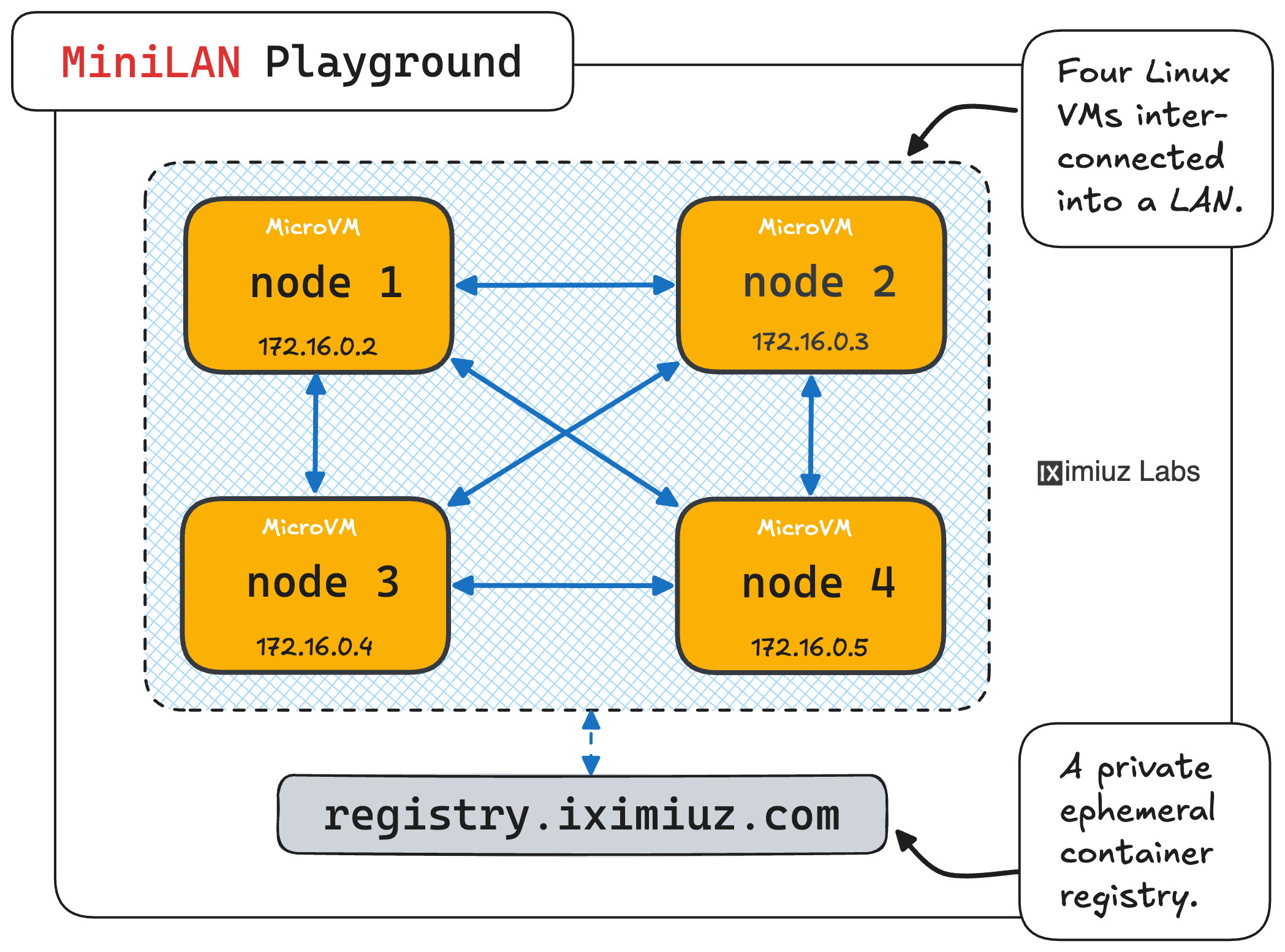
A multi-node playground example: 4 VMs and 1 ephemeral container registry sitting in the same LAN.
You can access the registry from any machine in the playgrounds using the following address:
registry.iximiuz.com
By default, the registry allows anonymous access. To restrict access, you can specify a username and password:
playground:
name: ...
registryAuth: <username>:<password>
💡 Since the registry is available only from the playgrounds, protecting it with a username and password is not required for most tutorials.
Background Tasks
One of the most powerful features of iximiuz Labs is its task execution engine. Each machine in the playground can run three types of tasks:
init: runs during playground initialization and has no UI representation except for the initial loading screen.helper: similar toinit, but doesn't block the playground from starting and can be used during the whole playground's lifetime.regular: the only user-facing type of tasks that are used to verify specific system conditions and/or accept user input.
Tasks in iximiuz Labs are used to:
- Run scripts to customize the playground's environment.
- Provide dynamic feedback as users follow along the learning material.
- Interact with the user and check that certain actions are performed correctly.
This sample tutorial demonstrates how to use all three types of tasks. Refer to the source of this tutorial on GitHub to see how the tasks are defined in the tutorial's Front Matter.
Initialization Task
An init task runs during playground initialization (before the UI is fully available).
It's vital for setting up the environment but is not reflected in the user interface.
For example:
---
kind: tutorial
title: ...
playground:
name: ...
tasks:
init_deploy_nginx:
# Init tasks are used to finalize the setup of the playground.
# Until all init tasks are completed, the playground screen shows
# a loading animation.
init: true
# By default, the task is executed on every machine of the playground.
# If the task needs to be executed only on a specific machine, you
# can specify it with the `machine` property. Beware, at the moment,
# either none or all tasks must have the `machine` property (in the latter case,
# different tasks may be executed on different machines).
machine: dev-machine
# By default, tasks are executed as the `root` user.
# If the task needs to be executed as a different user, you
# can specify it with the `user` property.
user: laborant
run: |
kubectl run nginx-01 --image=ghcr.io/iximiuz/labs/nginx:alpine --port=80
Regular Verification Task
Definition of a regular task in the Front Matter is identical to that of an init task (except for the init: true part).
However, regular tasks also have a corresponding markdown representation via a simple-task component:
::simple-task
---
:tasks: tasks
:name: <task-name>
---
#active
<what needs to be done / what system condition needs to be met>
#completed
<what has been done or any other confirmation of completion>
::
The simple-task component provides a visual representation of the task's progress and dynamic hints (if any).
Here's how it looks:
The above component is bound to the following task definition in the Front Matter (via the name property):
tasks:
# Regular tasks are used to check if certain system conditions are met
# and/or requested user actions are completed. Each regular task should
# have a visual representation in the content's body, and the total/done
# number of regular tasks is displayed in the content's header, serving
# as a main content completion indicator.
verify_file_exists:
machine: dev-machine
# The only mandatory property of a regular task is the `run` script.
# The task will be executed in a loop until it exits with 0.
run: |
if [ ! -f /tmp/some/file.txt ]; then
echo "This is a diagnostic message. The user won't see it, but it's helpful for debugging."
exit 1
fi
Try making the task to pass by executing the following command:
mkdir -p /tmp/some && echo "Hello, world!" > /tmp/some/file.txt
💡 Make sure you're executing the command from the dev-machine (and not any other machine in the playground).
User-Input Task
A user-input task is an alternative way to visualize a regular task. It is used when the task requires the user to submit specific data (for example, reading a value from a log). The input is validated, and if correct, it's passed to the corresponding task for further processing:
::user-input-task
---
:tasks: tasks
:name: <task-name>
:validateRegex: <optional regular expression, applied on the client-side>
:destination: <optional path to a file to store the input in the playground VM>
---
#active
<what needs to be entered by the user>
#completed
<confirmation of completion>
::
Here's an example of a user-input task UI element:
::user-input-task
---
:tasks: tasks
:name: input_container_name
:validateRegex: ^[0-9a-zA-Z-]{2,64}$
:destination: /tmp/container-name.txt
---
#active
Enter the name of the future container:
#completed
Nice one! You certainly have a good taste in names 🎉
::
Under the hood, the above user-input-task component is bound to the another regular task from the tutorial's Front Matter:
tasks:
...
# Tasks can also be used to collect user input. While it's up to the task's
# author to decide what to do with the input, the input is usually done via
# some well-known file (the task's UI element and the task's `run` script
# should agree on the file name beforehand).
# The task's `run` script can do anything with the provided user input.
input_container_name:
machine: dev-machine
# This task just echoes the user input (but usually, you'd want to assert
# something about the input).
run: |
# User input is available in the `x(.input)` template variable.
echo "x(.input)"
# If the `destination` property is set, user input is also stored in the file.
cat /tmp/container-name.txt
if [[ "x(.input)" != "my-awesome-container" ]]; then
echo "The container name is not as awesome as it should be."
exit 1
fi
hintcheck: |
echo "The container name is not as awesome as it should be."
echo "Try using 'my-awesome-container'."
Submit any valid container name to see the task to pass.
Task Dependencies
Tasks can depend on each other.
For example, the following task depends on the input_container_name task:
tasks:
...
verify_container_is_running:
machine: dev-machine
# Regular tasks run only after all init tasks are completed.
# By default, regular tasks run in parallel but the execution order
# can be controlled with the `needs` property.
needs:
- input_container_name
env:
# A handy way to pass the output of a previous task to the current one
# is to use the a template variable x(.needs.task_name.stdout|stderr).
# This example illustrates how to pass the output of the `input_container_name`
# task to the `verify_container_is_running` task.
- CONTAINER_NAME=x(.needs.input_container_name.stdout)
# The task engine also defines a number of higher-level helper functions
# that can be used in the `run` script. For example, `docker_container_is_running`
# is a helper function that checks if a container is running.
run: |
if ! docker_container_is_running ${CONTAINER_NAME}; then
echo "The container isn't running."
exit 1
fi
Notice how the needs property is used to control the order of task execution
and to access the output of (one of) the previous task(s) if needed.
Make the below task to pass by running the following command:
docker run -d --name NAME nginx:alpine
List of Built-in Helper Functions
The task engine defines a number of built-in helper functions that can be used in the run script:
#!/usr/bin/env bash
###############################################################################
# Docker
###############################################################################
docker_container_name() {
docker container inspect --format '{{.Name}}' "$@"
}
docker_container_pid() {
docker container inspect --format '{{.State.Pid}}' "$@"
}
docker_container_ip() {
docker container inspect --format '{{.NetworkSettings.IPAddress}}' "$@"
}
docker_container_image() {
docker container inspect --format '{{.Config.Image}}' "$@"
}
docker_container_image_id() {
docker container inspect --format '{{.Image}}' "$@"
}
docker_container_is_running() {
[ "$(docker container inspect --format '{{.State.Running}}' $@ 2>/dev/null)" = "true" ]
}
docker_container_exit_code() {
docker container inspect --format '{{.State.ExitCode}}' $@
}
docker_container_count_total() {
docker ps -aq | wc -l
}
docker_container_count_running() {
docker ps -q | wc -l
}
docker_image_id() {
docker image inspect --format '{{.Id}}' "$@"
}
docker_image_size_bytes() {
docker image inspect --format '{{.Size}}' "$@"
}
###############################################################################
# Podman
###############################################################################
podman_container_name() {
sudo podman inspect --format '{{.Name}}' "$@"
}
podman_container_pid() {
sudo podman inspect --format '{{.State.Pid}}' "$@"
}
podman_container_ip() {
sudo podman inspect --format '{{.NetworkSettings.IPAddress}}' "$@"
}
podman_container_is_running() {
[ "$(sudo podman inspect --format '{{.State.Running}}' $@ 2>/dev/null)" = "true" ]
}
podman_container_exit_code() {
sudo podman inspect --format '{{.State.ExitCode}}' $@
}
podman_container_count_total() {
sudo podman ps -aq | wc -l
}
podman_container_count_running() {
sudo podman ps -q | wc -l
}
###############################################################################
# nerdctl
###############################################################################
nerdctl_container_name() {
sudo nerdctl inspect --format '{{.Name}}' "$@"
}
nerdctl_container_pid() {
sudo nerdctl inspect --format '{{.State.Pid}}' "$@"
}
nerdctl_container_ip() {
sudo nerdctl inspect --format '{{.NetworkSettings.IPAddress}}' "$@"
}
nerdctl_container_is_running() {
[ "$(sudo nerdctl inspect --format '{{.State.Running}}' $@ 2>/dev/null)" = "true" ]
}
nerdctl_container_exit_code() {
sudo nerdctl inspect --format '{{.State.ExitCode}}' $@
}
nerdctl_container_count_total() {
sudo nerdctl ps -aq | wc -l
}
nerdctl_container_count_running() {
sudo nerdctl ps -q | wc -l
}
###############################################################################
# ctr
###############################################################################
ctr_container_netns() {
sudo lsns -p $(ctr_container_pid $@) -t net --nowrap --noheadings | awk '{print $1}'
}
ctr_container_pid() {
sudo ctr tasks ps "$@" | head -n 2 | tail -n 1 | awk '{print $1}'
}
ctr_container_is_running() {
sudo ctr tasks list | grep RUNNING | grep -F "$@" >/dev/null
}
ctr_container_count_total() {
sudo ctr containers list -q | wc -l
}
ctr_container_count_running() {
sudo ctr tasks list | grep RUNNING | wc -l
}
You can register your own helper functions by creating shell scripts in the following location:
/opt/iximiuz-labs/examiner/checks.d
Dynamic Hints and Failure Conditions
Sometimes, you may want to provide a hint to the user that depends on their actions in the playground.
It can be done by defining a hintcheck script for the task.
The content of the hintcheck script stdout and stderr will be displayed in the corresponding simple-task UI element as a so called dynamic hint.
Here is an example:
tasks:
...
# Ready tasks are executed in a loop until they either complete (exit with 0)
# or fail (exiting with a non-zero code doesn't mean failure, see failcheck for
# details). There is a small delay between consecutive executions of the task
# (currently 1 second, but it's subject to change).
verify_container_is_stopped:
machine: dev-machine
needs:
- input_container_name
- verify_container_is_running
env:
- CONTAINER_NAME=x(.needs.input_container_name.stdout)
run: |
if docker_container_is_running ${CONTAINER_NAME}; then
echo "The container is still running."
exit 1
fi
if ! docker ps -a | grep -q ${CONTAINER_NAME}; then
echo "The container is completely gone."
exit 1
fi
# Hintcheck is an optional run-like script that is executed after
# the task's `run` script. The exit code of the hintcheck script
# has no effect on the task's outcome. Any output of the hintcheck
# script (stdout and stderr) gets showed in the task's UI element as
# a dynamic hint.
hintcheck: |
if docker_container_is_running ${CONTAINER_NAME}; then
echo "The container is still running."
echo "Run 'docker stop ${CONTAINER_NAME}' to stop it."
fi
# Failcheck is an optional run-like script that is executed before
# the task's `run` instructions to validate that some critical
# (playground-wide) conditions are still met. If the failcheck exits
# with a non-zero exit code, the task is considered failed, and the whole
# playground transitively is marked as failed, too (i.e., the user will
# have to restart the current content attempt).
failcheck: |
if ! docker ps -a | grep -q ${CONTAINER_NAME}; then
echo "The container has been removed. You shouldn't have done that!"
echo "Please, restart the tutorial and try again."
exit 1
fi
Another handy feature of the task engine is the ability to define a failure condition for a task.
It can be done by defining a failcheck script for the task.
The content of the failcheck script stdout and stderr will also be displayed in the corresponding simple-task UI element,
but, unlike the hintcheck, if the failcheck scripts exits with a non-zero exit code, the whole playground will be marked as failed,
and the user will have to restart the content attempt.
Here is an example:
Try failing the task by running the following command:
docker rm -f NAME
Debugging Tasks
Oftentimes, tasks' scripts should be kept secret from the users as they can provide excessive details about the expected user actions (might be less important for Tutorials, but is crucial for Challenges, where the users are expected to come up with the right commands on their own).
Tasks are executed by a daemon process called examinerd, which runs on each machine in the playground.
By default, this daemon hides all the stdout and the stderr output of the tasks' scripts.
However, content authors can access the output of all tasks by either using the examinerctl CLI tool or the Tasks Dev Tools UI element.
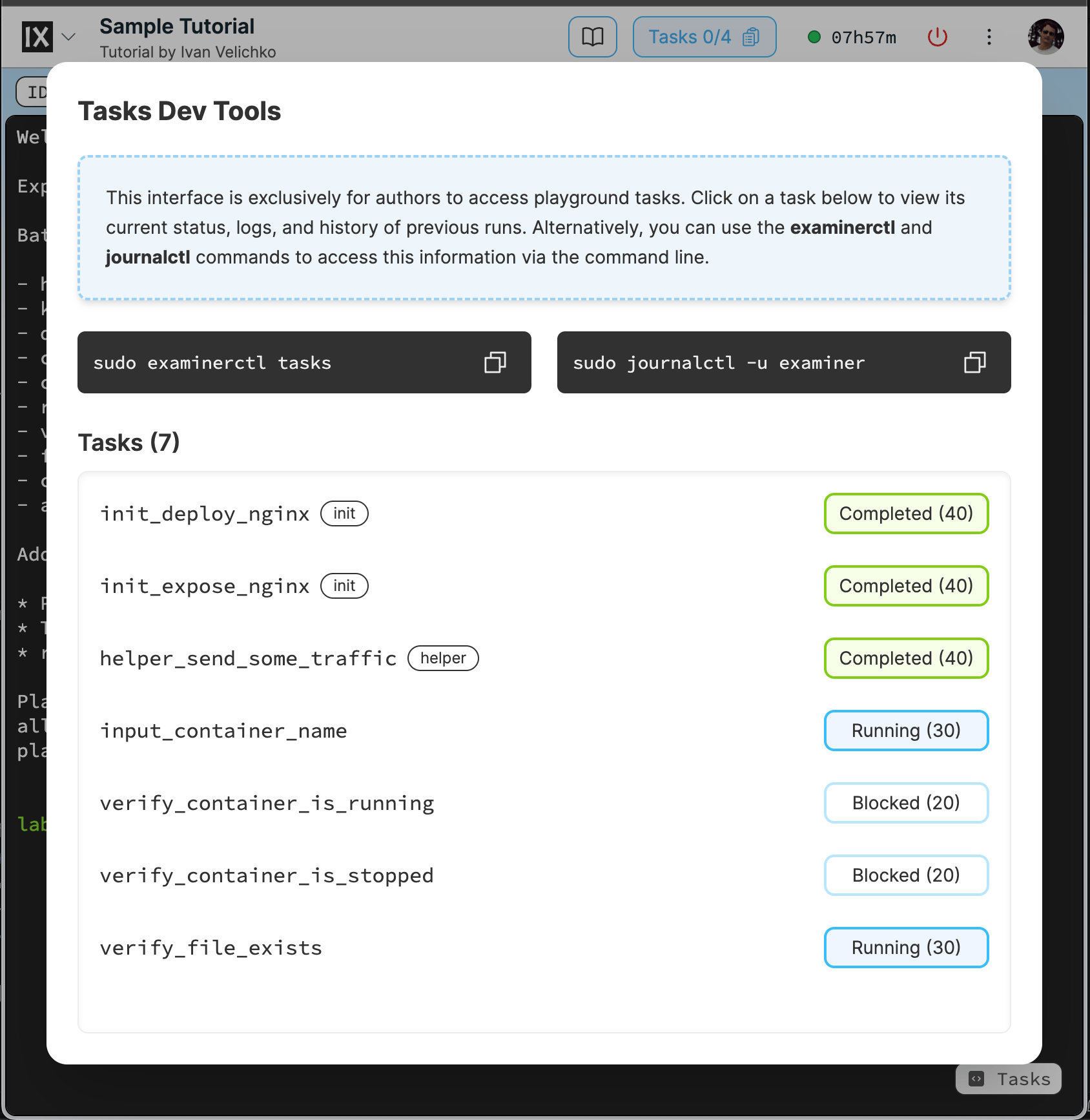
Tasks Dev Tools UI (available only to content authors).
To activate the Tasks Dev Tools, find the Tasks button in the bottom-right corner of the playground and click on it.
Instead of Conclusion
Remember:
- Titles are 80% of success - take your time to craft a good one.
- Keep it short and concise - avoid fluff and keep the text to the point.
- Use concrete words and provide examples - they make the tutorial testifiable (and falsifiable).
- Use bullet points and lists - they make the text more readable and engaging.
- Use (lots of) images - a picture is indeed worth a thousand words.
- Explain what you're going to explain, how, and why - this pattern works so well!
- Beware of the "But & Therefore rule" - it works even for technical writing.
Happy authoring!
Level up your Server Side game — Join 20,000 engineers who receive insightful learning materials straight to their inbox
